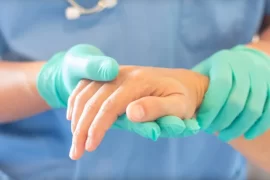A pelvic floor disorder (PFD) occurs when the muscles or connective tissues of the pelvic area weaken or are injured. The most common pelvic floor disorders are urinary incontinence, fecal incontinence, and pelvic organ prolapse. PFDs are more common among older women.
People with pelvic floor disorders may experience: Urinary problems, such as an urgent need to urinate, painful urination or incomplete emptying of their bladder. Constipation, straining or pain during bowel movements is a sign of pelvic floor disorder, as well as pain or pressure in the vagina or rectum.
The “pelvic floor” refers to a group of muscles that attach to the front, back, and sides of the pelvic bone and sacrum (the large fused bone at the bottom of your spine, just above the tailbone). Like a sling or hammock, these muscles support the organs in the pelvis, including the bladder, uterus or prostate, and rectum. They also wrap around your urethra, rectum, and vagina (in women).
Coordinated contracting and relaxing of these muscles controls bowel and bladder functions—the pelvic floor must relax to allow for urination, bowel movements, and, in women, sexual intercourse.
Symptoms of PFD include: Urinary urgency, frequency, hesitancy, stopping and starting of urine stream, painful urination, or incomplete emptying, Constipation, straining, pain with bowel movements, Unexplained pain in the low back, pelvic region, genital area, or rectum, Pain during or after intercourse, orgasm, or sexual stimulation, Uncoordinated muscle contractions causing the pelvic floor muscles to spasm.
Side effects of certain medicines commonly used to treat interstitial cystitis (IC), such as tricyclic antidepressants (amitriptyline, imipramine, and others), may worsen PFD symptoms.
Physicians or physical therapists (PT) that are specially trained in treating PFD diagnose the condition during a physical examination. Using external and internal “hands-on” or manual techniques to evaluate the function of the pelvic floor muscles, they can assess your ability to contract and relax these muscles.
Bones and muscles of your lower back, hips, and sacroiliac joint can stress your pelvic floor muscles. Your doctor or PT will first check externally and internally for problems such as muscle spasms, muscle knots, and weakness or sacroiliac misalignment (where your sacrum and upper hipbones meet).
If an internal examination is too uncomfortable for you, your doctor or physical therapist may use externally placed electrodes, placed on the perineum (area between the vagina and rectum in women/testicles and rectum in men) and/or sacrum (a triangular bone at the base of your spine) to measure whether you are able to effectively contract and relax your pelvic floor muscles.
Another way to measure pelvic floor contractions is with a perineometer, a small, tampon-like sensing device placed into the vagina or rectum.
Currently there is no surefire way to distinguish PFD from IC, and oftentimes patients have both conditions. Some healthcare providers examine pelvic floor muscles externally and internally to gauge their tightness (tightness indicates PFD).
The goal of PFD therapy for IC patients is to relax these muscles and avoid stressing them. Treatment usually combines self-care, medicines, physical therapy, and home exercise.

Self-Care—Avoid pushing or straining when urinating and ask your healthcare provider about how to treat constipation. Relaxing the muscles in the pelvic floor area overall is important. Using methods such as warm baths at least twice a day is helpful.
Medicines—Low doses of muscle relaxants such as diazepam (Valium), 2 mg three times a day, may be helpful. Maintaining good posture to keep pressure off your bladder and pelvic organs and using stretching or other techniques such as yoga to avoid tightening and spasms in the other pelvic muscles, also help PFD therapy to succeed.
Physical therapy—a physical therapist specially trained in pelvic floor rehabilitation may take the following steps to help you obtain relief from your PFD:
-External and internal evaluation of your pelvis
-External and internal manual therapy
-Application of various devices to help relax your pelvic floor
-Training in home exercise and therapy
External and internal manual therapy
The therapist may do manual therapy or massage both externally and internally to stabilize your pelvis before using other kinds of treatment. Manual therapy takes time and patience, and may require one to three sessions per week, depending on the technique used and your response to treatment. You may feel worse initially. However, many patients see improvement after six to eight weeks.
For internal massage, your PT may insert a finger into the vagina or rectum and massage the muscles and connective tissue directly. A frequently used technique is “Thiele stripping,” in which your therapist finds a trigger point by feeling a twitch in the muscle underneath, exercising it using a circular motion, and then putting pressure on it to help relax it, repeating the process until the muscle starts to release. Internal massage can also help release nerves. Sometimes, anesthetics can be injected into these trigger points. PTs may do this in a few states, but in most states, a doctor or nurse must administer injections.
If there is too much discomfort with internal therapy techniques, your PT may start with external techniques to help you begin to relax these muscles, including:
Skin rolling
Deep tissue massage, often called “myofascial release”
Trigger-point therapy to release tight spots or “knots”
Nerve release
Joint mobilization
Application of various devices and therapies to help relax your pelvic floor
PTs also use a variety of devices and therapies to help you learn to relax your pelvic floor or to treat your pelvic pain directly.
Biofeedback uses electrodes placed on your body (on the perineum and/or the area around the anus) or probes inserted in the vagina or rectum to sense the degree of tenseness in your pelvic floor muscles. Results displayed on a computer or other device provides cues to help you learn to relax those muscles. Usually, patients feel relief after six to eight weeks of therapy. You may be able to buy or rent a unit to use at home.
Electrical stimulation uses a small probe inserted into the vagina or rectum to stimulate your pelvic floor muscles, helping desensitize nerves and causing muscles to contract and relax. Stimulation through electrodes placed on your body may calm pain and spasms. Different kinds of electrical stimulation devices are available for home use, both for internal stimulation with a probe or for external stimulation, such as a transcutaneous electrical nerve stimulation (TENS) or similar unit, to ease pain.
Interferential therapy is a kind of electrical stimulation delivered from electrodes placed on the skin. The impulses “interfere” with each other at the point of pain deep in tissues and can replace and relieve the sensations of spasm. Home units are available.
Ultrasound uses high-frequency sound waves applied through a wand or probe on your skin to produce an internal image or to help treat pain. Real-time ultrasound can let you see your pelvic floor muscles functioning and help you learn to relax them. Therapeutic ultrasound uses sound waves to produce deep warmth that may help reduce spasm and increase blood flow or, on a nonthermal setting, may promote healing and reduce inflammation.
Cold laser applies low-intensity laser light to the tissue and may help with pain, inflammation, and wound healing. Some devices have FDA approval for temporary relief of minor muscle aches, joint pain and stiffness, and for relaxation of muscle spasm and increasing local blood flow.
Home exercise and therapy is also a mainstay of PFD rehabilitation. Because the goal of PFD therapy is to learn to control and, especially, relax the pelvic floor, therapists will teach you techniques for use at home to build on the therapies they do in their offices. This usually begins with general relaxation, stretching the leg and back muscles, maintaining good posture, and visualization—part of learning to sense your pelvic floor muscles and to relax them.
Source: interstitial cystitis Association




